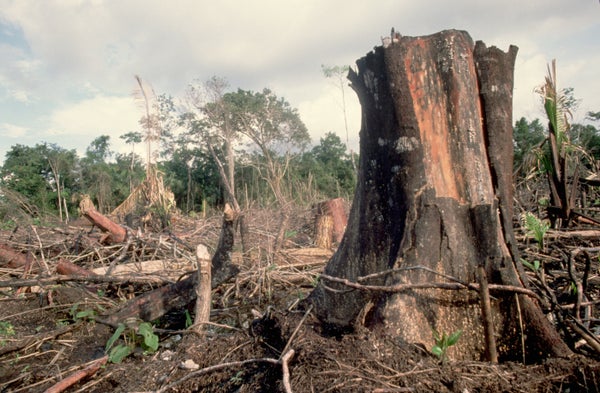This article was published in Scientific American’s former blog network and reflects the views of the author, not necessarily those of Scientific American
We can’t be shortsighted as the world triages COVID-19. We also need to triage—now—how to prevent future zoonotic outbreaks.
The health of all life on the planet is connected. The COVID-19 outbreak starkly reminds us of a basic fact that cannot be ignored: Human, animal, plant and environmental health and well-being are all intrinsically connected and profoundly influenced by human activities. Health entails more than the absence of infectious disease; it must incorporate socioeconomic, political, evolutionary and environmental factors while considering individual attributes and behaviors.
Hence, a multidisciplinary approach integrating and funding experts in animal, ecosystem and human health is urgently needed. The federal government has taken critical action, but further targeted actions are indicated by what we can learn from conservationists, social scientists, ecologists and wildlife managers, who are essential for ensuring our public health.
On supporting science journalism
If you're enjoying this article, consider supporting our award-winning journalism by subscribing. By purchasing a subscription you are helping to ensure the future of impactful stories about the discoveries and ideas shaping our world today.
Coronaviruses, like the novel coronavirus SARS-CoV-2, which causes COVID-19, are not uncommon. Humans and animals naturally host and travel with a multitude of pathogens, including these viruses. Viruses can infect their carriers, leading to disease and possibly death. They can also be innocuous, and the unperturbed humans or animals become their “reservoir hosts.”
Ignorance concerning this coronavirus abounds. The World Health Organization calls the spread of misinformation an “infodemic.” It spreads over social media like a virus. We should know better. The WHO estimates that some 60 percent of all viruses that infect humans come from animals. This phenomenon is termed “zoonosis.” The WHO finds that 75 percent of new infectious diseases in the past decade are zoonotic.
What can we do to prevent infection by the next emerging virus? What would we give today to have averted the pandemic of HIV/AIDS, a lentivirus that was traced to human contact with infected chimpanzees and sooty mangabeys in West Africa? The SARS epidemic in 2002 began through human contact with a mammal, the civet, which bats had infected with the coronavirus.
It pays to remember that zoonotic spillovers at the wildlife-human interface are neither one-off events nor only found in distant lands. We know them as rabies, West Nile virus, plague, salmonellosis, hantavirus or Lyme disease. Humans strive mightily to avoid these zoonotic diseases.
Our interface with wildlife is affected by land-use changes, activities such as logging/deforestation, the expansion of agriculture into previously undisturbed areas and a massive trade in wildlife, all altering the normal circulation of viruses and shifting the composition, abundance and behavior of viral reservoir species. These changes increase contact-rates between virus-carrying animals and humans (and vice versa).
Benjamin Franklin advised in 1736 that “An ounce of prevention is worth a pound of cure.” Do we not each wash our hands often to prevent contact with viruses? Does our global society not need to do even more about “germs” that afflict us? Viruses that inhabit wild animals can infect domesticated animals, and similarly livestock diseases can decimate the last wildlife populations.
African swine fever is today wiping out pig production across Asia and threatens farms in Europe and North America. For the highly endangered wild pig species of Southeast Asia, this virus could be the final blow.
Large proportions of the world still fail to implement global sanitary standards in livestock production and trade in animals and their products. The large-scale urban consumption of wildlife knows no standards and can never be considered sanitary and safe. Humans everywhere are at risk.
What can we do?
In October 2019, weeks before the epidemic appeared in China, the Wildlife Conservation Society and the German government recommended robust action to strengthen global health. The Berlin Principles, for “One Planet, One Health, One Future,” set forth 10 practical steps, prescriptions for healthy communities. Governments at all levels should heed these guidelines.
Through the Berlin Principles, communities can better “integrate understanding of human and animal health with the health of the environment” and act to restore and maintain healthy ecosystems to avert releases of diseases.
Waiting to act until a disease infects a human is too late. COVID-19 now is found across the globe, while public health officials work overtime to detect, trace, isolate and treat new cases. As government labs and pharmaceutical companies race to find a vaccine for this virus, we must not lose focus.
Instead, we must devise adaptive, holistic and forward-looking approaches to the detection, prevention, monitoring, control and mitigation of emerging infectious diseases that incorporate the complex interconnections among species, ecosystems and human society, while accounting fully for harmful economic drivers and perverse subsidies.
While the bipartisan $8 billion supplemental appropriation to allocate emergency funds to confront the COVID-19 pandemic recently signed by President Trump is essential, we can and must do more to ensure that we stay several steps ahead of the next zoonotic disease outbreak by supporting policy efforts at an international scale to permanently close the so-called “wet markets” where wildlife is traded and trafficked for human consumption, and continuing to fund global wildlife surveillance.
As we urgently attend to the sick, we must urgently embrace a one health approach and take action to increase cross-sectoral investment in the global human, livestock, wildlife, plant and ecosystem health infrastructure and international funding mechanisms for the protection of ecosystems, commensurate with the critical nature of emerging infectious disease threats to life on our planet.
Read more about the coronavirus outbreak here.
